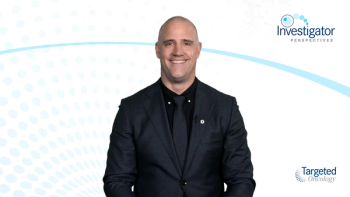
Case 2: Steroid-Refractory Chronic GVHD
The experts present and discuss the case of a patient with steroid-refractory chronic GVHD and discuss treatment options.
Yi-Bin Chen, MD: We’ll move on to our second case, and Dr Chao will present case 2.
Nelson Chao, MD: This is a 45-year-old man, status post-myeloablative unrelated donor peripheral blood transplant for AML [acute myeloid leukemia]. He received standard tacrolimus and methotrexate for GVHD [graft-versus-host disease] prophylaxis. Two months into the transplant he had stage 2 acute graft-versus-host of the skin, treated with topical steroids, and 12 months after the transplant he had developed the sensation of having sand in his eyes. He was treated with topical agents by his ophthalmologist, and then he developed muscle and joint pain, limiting his daily exercise routine, and started an oral prednisone at 1 mg/kg per day. He responded to that, but at 18 months after transplant, while he was being tapered from steroids, sclerodermatous changes developed, which showed a decreased range of motion of the shoulder joints.
Yi-Bin Chen, MD: Before we jump in, Dr Chao, in aggregate, what percentages of our patients after transplant are afflicted by moderate-to-severe chronic graft-versus-host disease, so that which involves us treating and paying attention and adding back therapy?
Nelson Chao, MD: Around 50% to 60% develop enough chronic GVHD that you worry about it.
Yi-Bin Chen, MD: There were interesting data presented at the recent TCT [Transplantation & Cellular Therapy] meetings from a large study from the Chronic GVHD Consortium that suggested that about one-third of patients who are started on immunosuppressive therapy are ultimately able to come off. This begs the question, how do we counsel patients who present with new chronic graft-versus-host disease in terms of what the expectation should be and how long they’ll be on medication?
Pashna N. Munshi, MD: It’s a long road; these end up being your patients for their lifetime when they become debilitated if the progression continues. Certain steroids are the greater evil here, but they may do something quickly for them. I am also quick to start them on photopheresis or another line of therapy because we know that they’re going to need something in addition, so that we can wean off the systemic steroids quickly. These patients are at high risk for opportunistic infections. I do counsel them to maintain hygiene, take care of skincare needs. They may have to go to specialists like wound care, and they have to go to the physical therapist to understand their debility in terms of restriction to their movements and involvement of the fascia. It’s a crew of people who are needed at this time, and patients can get frustrated by the number of visits they may have to have at the medical center.
Yi-Bin Chen, MD: It is not surprising to any of us, based on the history, that this patient developed chronic graft-versus-host disease. There are certain risk factors that we know about and look for, just like in acute GVHD, such as the myeloablative conditioning regimen and use of peripheral blood stem cells. The biggest risk factor we’ve all seen in large studies is prior acute graft-versus-host disease. That sets the patient up to develop chronic graft-versus-host disease at some point. Dr Chao, would you say that this was appropriate first-line of therapy for this type of disease, or do you use something different in terms of starting therapy for this type of patient?
Nelson Chao, MD: No, I don’t do anything different. I don’t know that I would have started this patient on 1 mg/kg, I might have started on 0.5 mg/kg to see if that was enough. This patient did not have the same sense of urgency as the first patient, so you can get away with a lower dose of steroids.
This transcript has been edited for clarity.










































